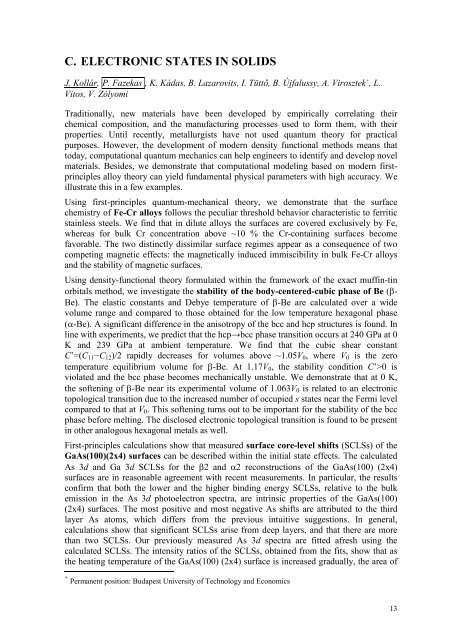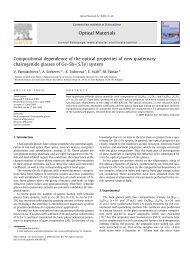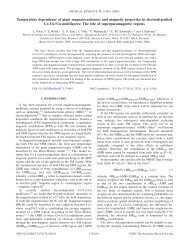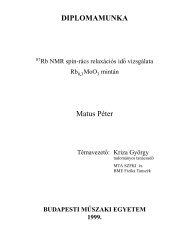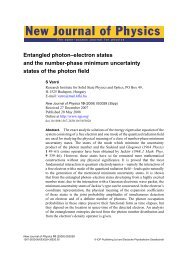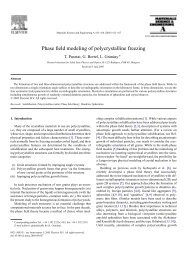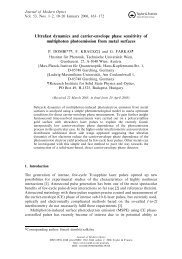ANNUAL REPORT - MTA SzFKI
ANNUAL REPORT - MTA SzFKI
ANNUAL REPORT - MTA SzFKI
You also want an ePaper? Increase the reach of your titles
YUMPU automatically turns print PDFs into web optimized ePapers that Google loves.
C. ELECTRONIC STATES IN SOLIDS<br />
J. Kollár, P. Fazekas , K. Kádas, B. Lazarovits, I. Tüttő, B. Újfalussy, A. Virosztek + , L.<br />
Vitos, V. Zólyomi<br />
Traditionally, new materials have been developed by empirically correlating their<br />
chemical composition, and the manufacturing processes used to form them, with their<br />
properties. Until recently, metallurgists have not used quantum theory for practical<br />
purposes. However, the development of modern density functional methods means that<br />
today, computational quantum mechanics can help engineers to identify and develop novel<br />
materials. Besides, we demonstrate that computational modeling based on modern firstprinciples<br />
alloy theory can yield fundamental physical parameters with high accuracy. We<br />
illustrate this in a few examples.<br />
Using first-principles quantum-mechanical theory, we demonstrate that the surface<br />
chemistry of Fe-Cr alloys follows the peculiar threshold behavior characteristic to ferritic<br />
stainless steels. We find that in dilute alloys the surfaces are covered exclusively by Fe,<br />
whereas for bulk Cr concentration above ~10 % the Cr-containing surfaces become<br />
favorable. The two distinctly dissimilar surface regimes appear as a consequence of two<br />
competing magnetic effects: the magnetically induced immiscibility in bulk Fe-Cr alloys<br />
and the stability of magnetic surfaces.<br />
Using density-functional theory formulated within the framework of the exact muffin-tin<br />
orbitals method, we investigate the stability of the body-centered-cubic phase of Be (β-<br />
Be). The elastic constants and Debye temperature of β-Be are calculated over a wide<br />
volume range and compared to those obtained for the low temperature hexagonal phase<br />
(α-Be). A significant difference in the anisotropy of the bcc and hcp structures is found. In<br />
line with experiments, we predict that the hcp→bcc phase transition occurs at 240 GPa at 0<br />
K and 239 GPa at ambient temperature. We find that the cubic shear constant<br />
C’=(C 11 −C 12 )/2 rapidly decreases for volumes above ~1.05V 0 , where V 0 is the zero<br />
temperature equilibrium volume for β-Be. At 1.17V 0 , the stability condition C’>0 is<br />
violated and the bcc phase becomes mechanically unstable. We demonstrate that at 0 K,<br />
the softening of β-Be near its experimental volume of 1.063V 0 is related to an electronic<br />
topological transition due to the increased number of occupied s states near the Fermi level<br />
compared to that at V 0 . This softening turns out to be important for the stability of the bcc<br />
phase before melting. The disclosed electronic topological transition is found to be present<br />
in other analogous hexagonal metals as well.<br />
First-principles calculations show that measured surface core-level shifts (SCLSs) of the<br />
GaAs(100)(2x4) surfaces can be described within the initial state effects. The calculated<br />
As 3d and Ga 3d SCLSs for the β2 and α2 reconstructions of the GaAs(100) (2x4)<br />
surfaces are in reasonable agreement with recent measurements. In particular, the results<br />
confirm that both the lower and the higher binding energy SCLSs, relative to the bulk<br />
emission in the As 3d photoelectron spectra, are intrinsic properties of the GaAs(100)<br />
(2x4) surfaces. The most positive and most negative As shifts are attributed to the third<br />
layer As atoms, which differs from the previous intuitive suggestions. In general,<br />
calculations show that significant SCLSs arise from deep layers, and that there are more<br />
than two SCLSs. Our previously measured As 3d spectra are fitted afresh using the<br />
calculated SCLSs. The intensity ratios of the SCLSs, obtained from the fits, show that as<br />
the heating temperature of the GaAs(100) (2x4) surface is increased gradually, the area of<br />
+ Permanent position: Budapest University of Technology and Economics<br />
13


